Operation and Project Management Report: Hotpoint Appliance Analysis
VerifiedAdded on 2020/06/06
|18
|4215
|347
Report
AI Summary
This report provides a comprehensive analysis of operation and project management principles, focusing on their application within the context of the Hotpoint appliance company. The assignment begins with an introduction to operation management, highlighting its significance in enhancing product quality and efficiency. It then delves into a review and critique of the execution of operation management principles, including manpower planning, cost management, machinery utilization, material sourcing, methods standardization, and supply chain management. The report explores the application of Six Sigma and Lean principles in operation management, including the DMAIC and Lean methodologies. Furthermore, the report presents a continuous improvement plan based on the principles of operation management, analyzing current and expected performance across various operational aspects. The application of the Product Life Cycle (PLC) is discussed, and the effectiveness of the PLC in project application is evaluated. The report concludes with references.
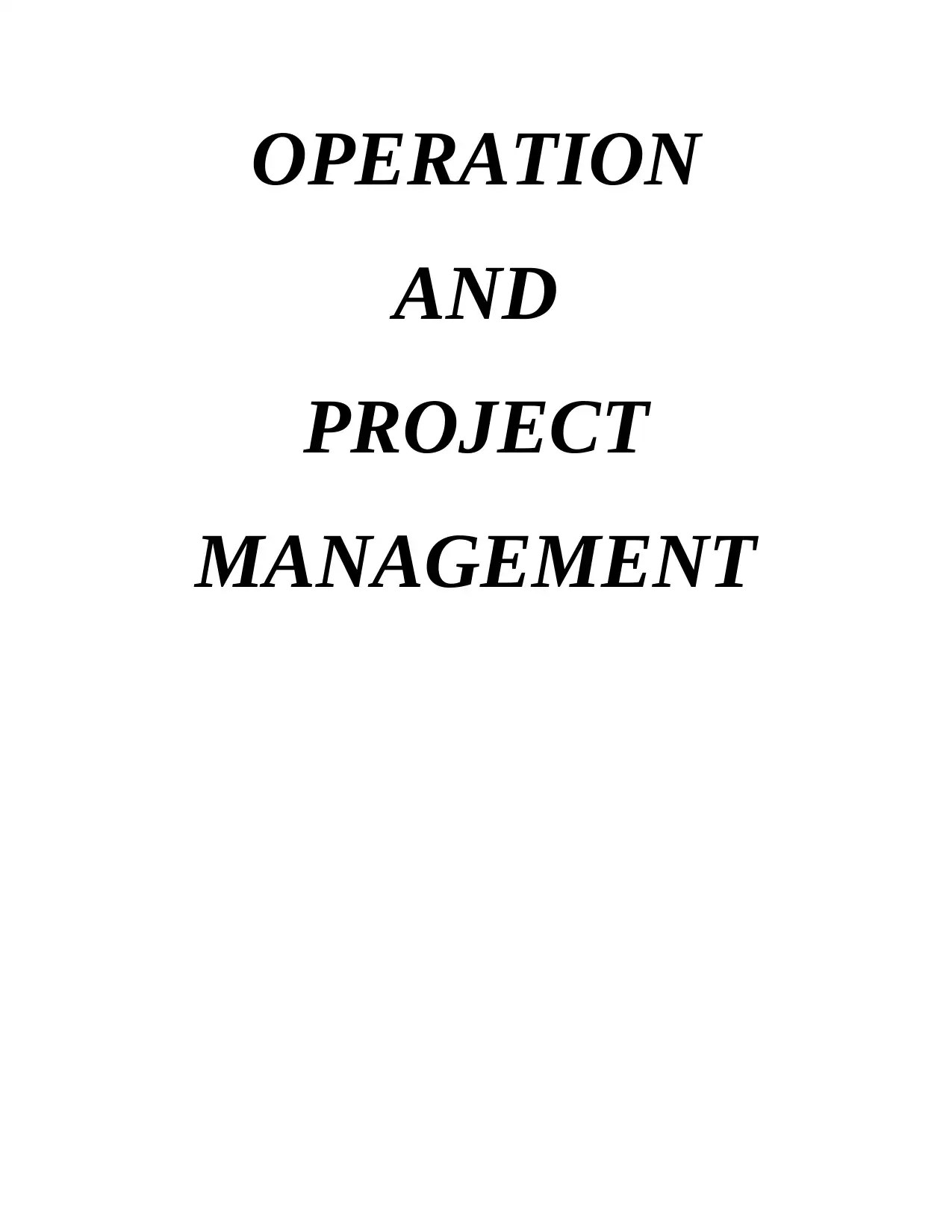
OPERATION
AND
PROJECT
MANAGEMENT
AND
PROJECT
MANAGEMENT
Paraphrase This Document
Need a fresh take? Get an instant paraphrase of this document with our AI Paraphraser
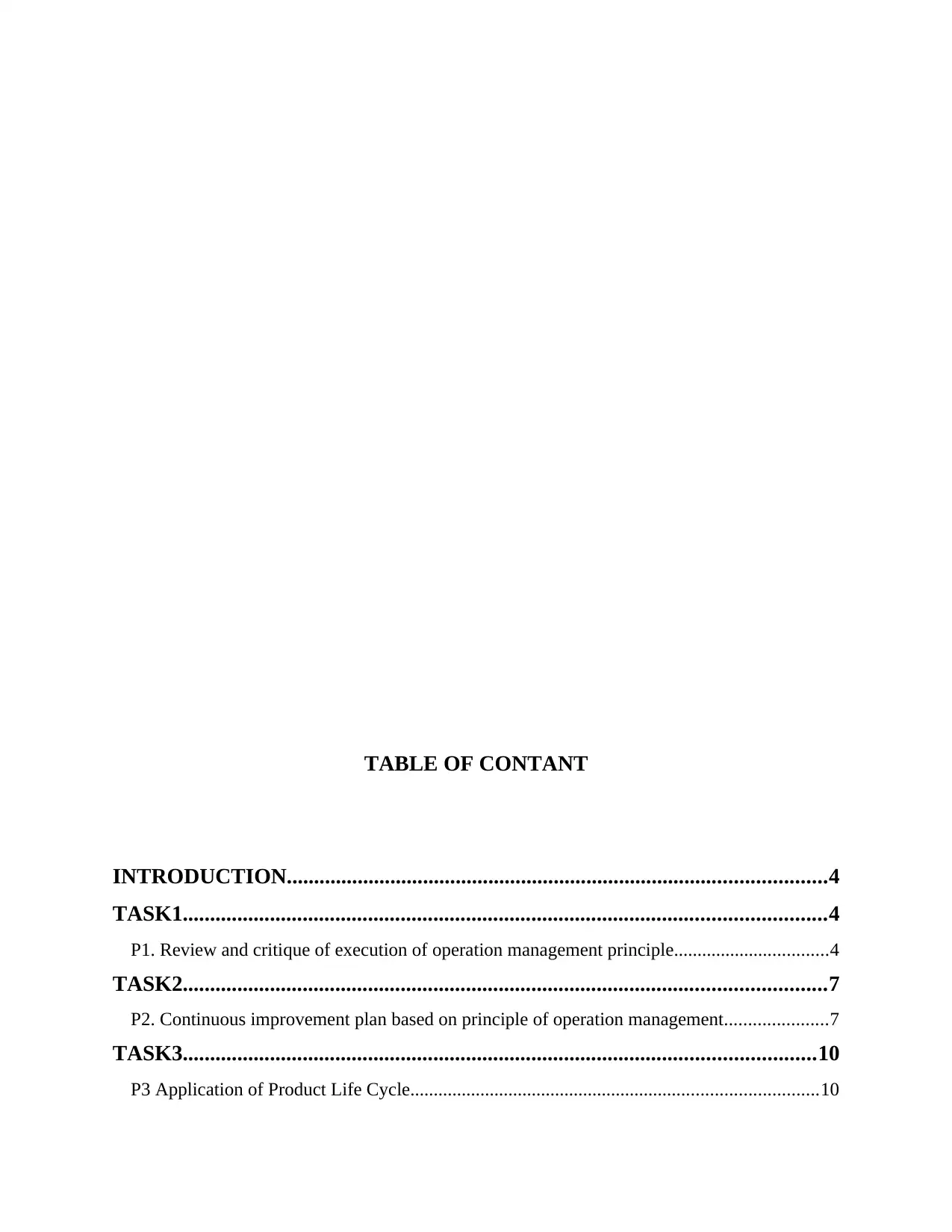
TABLE OF CONTANT
INTRODUCTION...................................................................................................4
TASK1......................................................................................................................4
P1. Review and critique of execution of operation management principle.................................4
TASK2......................................................................................................................7
P2. Continuous improvement plan based on principle of operation management......................7
TASK3....................................................................................................................10
P3 Application of Product Life Cycle.......................................................................................10
INTRODUCTION...................................................................................................4
TASK1......................................................................................................................4
P1. Review and critique of execution of operation management principle.................................4
TASK2......................................................................................................................7
P2. Continuous improvement plan based on principle of operation management......................7
TASK3....................................................................................................................10
P3 Application of Product Life Cycle.......................................................................................10
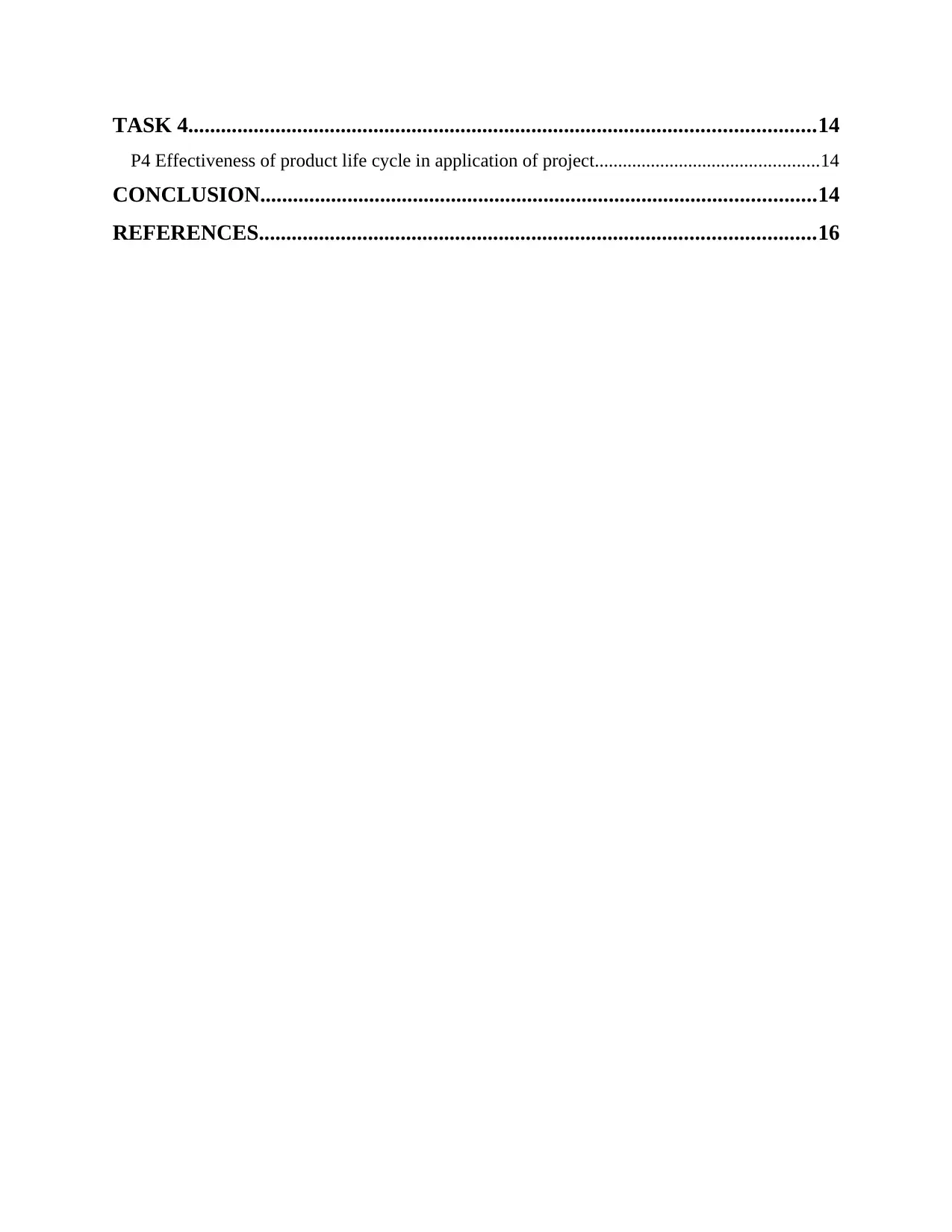
TASK 4...................................................................................................................14
P4 Effectiveness of product life cycle in application of project................................................14
CONCLUSION......................................................................................................14
REFERENCES......................................................................................................16
P4 Effectiveness of product life cycle in application of project................................................14
CONCLUSION......................................................................................................14
REFERENCES......................................................................................................16
⊘ This is a preview!⊘
Do you want full access?
Subscribe today to unlock all pages.

Trusted by 1+ million students worldwide

Paraphrase This Document
Need a fresh take? Get an instant paraphrase of this document with our AI Paraphraser
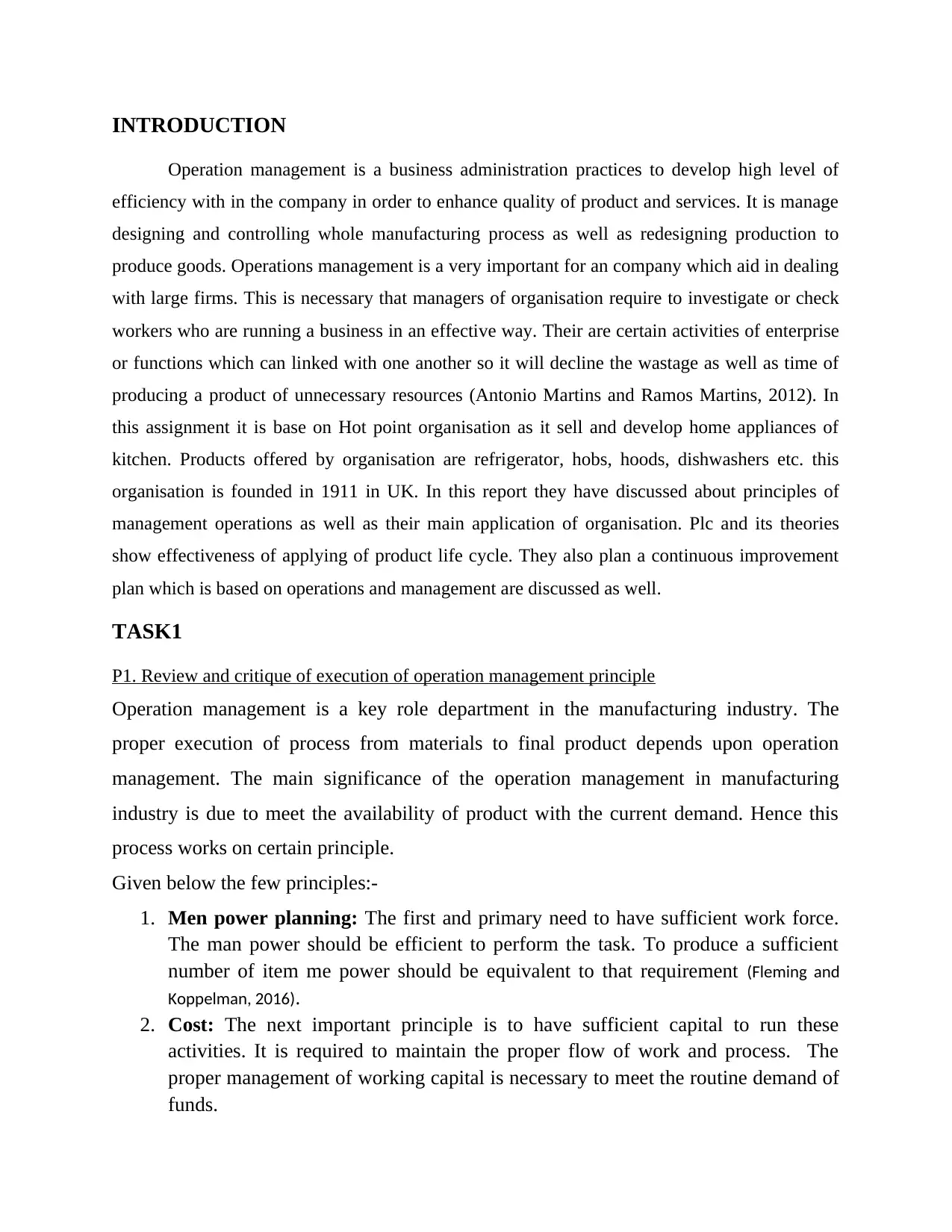
INTRODUCTION
Operation management is a business administration practices to develop high level of
efficiency with in the company in order to enhance quality of product and services. It is manage
designing and controlling whole manufacturing process as well as redesigning production to
produce goods. Operations management is a very important for an company which aid in dealing
with large firms. This is necessary that managers of organisation require to investigate or check
workers who are running a business in an effective way. Their are certain activities of enterprise
or functions which can linked with one another so it will decline the wastage as well as time of
producing a product of unnecessary resources (Antonio Martins and Ramos Martins, 2012). In
this assignment it is base on Hot point organisation as it sell and develop home appliances of
kitchen. Products offered by organisation are refrigerator, hobs, hoods, dishwashers etc. this
organisation is founded in 1911 in UK. In this report they have discussed about principles of
management operations as well as their main application of organisation. Plc and its theories
show effectiveness of applying of product life cycle. They also plan a continuous improvement
plan which is based on operations and management are discussed as well.
TASK1
P1. Review and critique of execution of operation management principle
Operation management is a key role department in the manufacturing industry. The
proper execution of process from materials to final product depends upon operation
management. The main significance of the operation management in manufacturing
industry is due to meet the availability of product with the current demand. Hence this
process works on certain principle.
Given below the few principles:-
1. Men power planning: The first and primary need to have sufficient work force.
The man power should be efficient to perform the task. To produce a sufficient
number of item me power should be equivalent to that requirement (Fleming and
Koppelman, 2016).
2. Cost: The next important principle is to have sufficient capital to run these
activities. It is required to maintain the proper flow of work and process. The
proper management of working capital is necessary to meet the routine demand of
funds.
Operation management is a business administration practices to develop high level of
efficiency with in the company in order to enhance quality of product and services. It is manage
designing and controlling whole manufacturing process as well as redesigning production to
produce goods. Operations management is a very important for an company which aid in dealing
with large firms. This is necessary that managers of organisation require to investigate or check
workers who are running a business in an effective way. Their are certain activities of enterprise
or functions which can linked with one another so it will decline the wastage as well as time of
producing a product of unnecessary resources (Antonio Martins and Ramos Martins, 2012). In
this assignment it is base on Hot point organisation as it sell and develop home appliances of
kitchen. Products offered by organisation are refrigerator, hobs, hoods, dishwashers etc. this
organisation is founded in 1911 in UK. In this report they have discussed about principles of
management operations as well as their main application of organisation. Plc and its theories
show effectiveness of applying of product life cycle. They also plan a continuous improvement
plan which is based on operations and management are discussed as well.
TASK1
P1. Review and critique of execution of operation management principle
Operation management is a key role department in the manufacturing industry. The
proper execution of process from materials to final product depends upon operation
management. The main significance of the operation management in manufacturing
industry is due to meet the availability of product with the current demand. Hence this
process works on certain principle.
Given below the few principles:-
1. Men power planning: The first and primary need to have sufficient work force.
The man power should be efficient to perform the task. To produce a sufficient
number of item me power should be equivalent to that requirement (Fleming and
Koppelman, 2016).
2. Cost: The next important principle is to have sufficient capital to run these
activities. It is required to maintain the proper flow of work and process. The
proper management of working capital is necessary to meet the routine demand of
funds.
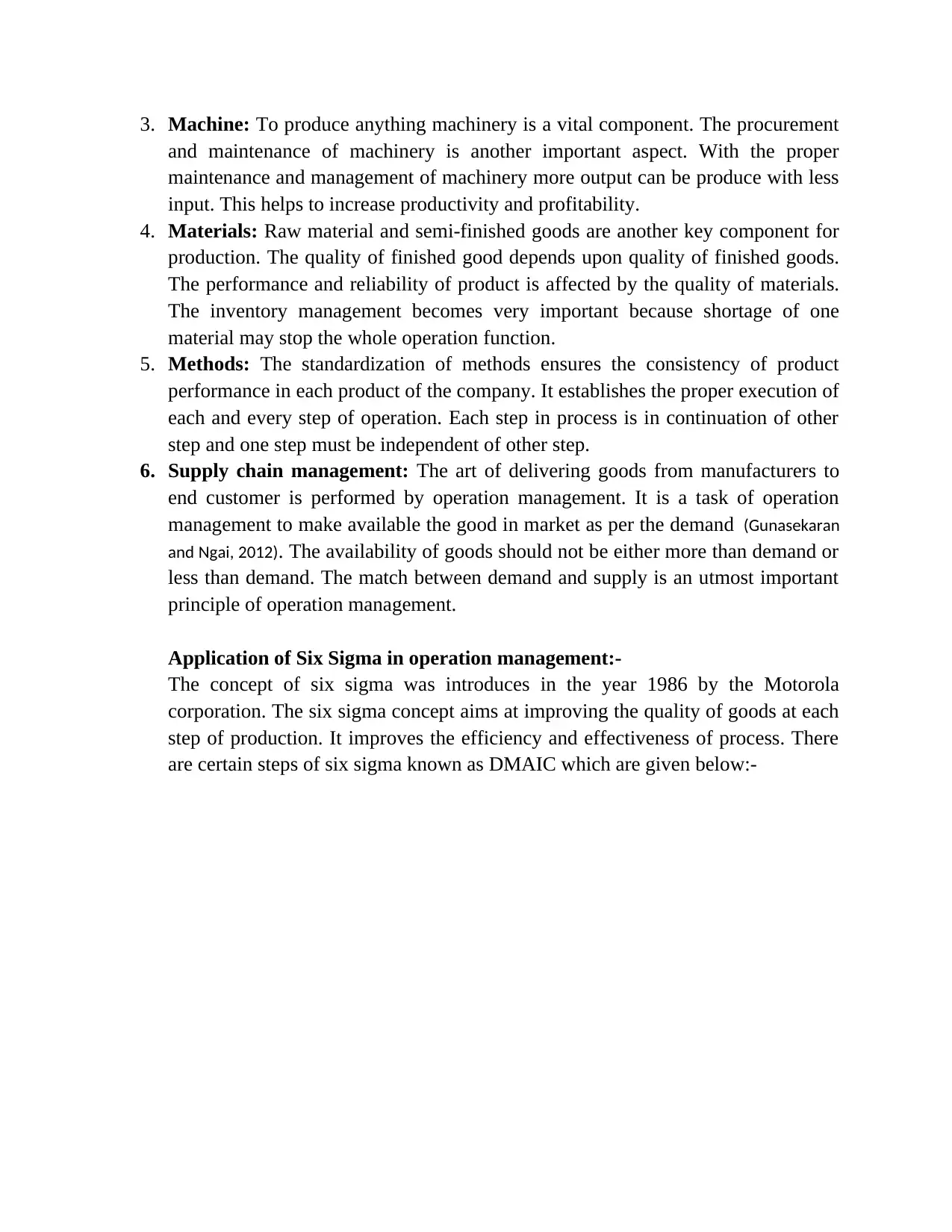
3. Machine: To produce anything machinery is a vital component. The procurement
and maintenance of machinery is another important aspect. With the proper
maintenance and management of machinery more output can be produce with less
input. This helps to increase productivity and profitability.
4. Materials: Raw material and semi-finished goods are another key component for
production. The quality of finished good depends upon quality of finished goods.
The performance and reliability of product is affected by the quality of materials.
The inventory management becomes very important because shortage of one
material may stop the whole operation function.
5. Methods: The standardization of methods ensures the consistency of product
performance in each product of the company. It establishes the proper execution of
each and every step of operation. Each step in process is in continuation of other
step and one step must be independent of other step.
6. Supply chain management: The art of delivering goods from manufacturers to
end customer is performed by operation management. It is a task of operation
management to make available the good in market as per the demand (Gunasekaran
and Ngai, 2012). The availability of goods should not be either more than demand or
less than demand. The match between demand and supply is an utmost important
principle of operation management.
Application of Six Sigma in operation management:-
The concept of six sigma was introduces in the year 1986 by the Motorola
corporation. The six sigma concept aims at improving the quality of goods at each
step of production. It improves the efficiency and effectiveness of process. There
are certain steps of six sigma known as DMAIC which are given below:-
and maintenance of machinery is another important aspect. With the proper
maintenance and management of machinery more output can be produce with less
input. This helps to increase productivity and profitability.
4. Materials: Raw material and semi-finished goods are another key component for
production. The quality of finished good depends upon quality of finished goods.
The performance and reliability of product is affected by the quality of materials.
The inventory management becomes very important because shortage of one
material may stop the whole operation function.
5. Methods: The standardization of methods ensures the consistency of product
performance in each product of the company. It establishes the proper execution of
each and every step of operation. Each step in process is in continuation of other
step and one step must be independent of other step.
6. Supply chain management: The art of delivering goods from manufacturers to
end customer is performed by operation management. It is a task of operation
management to make available the good in market as per the demand (Gunasekaran
and Ngai, 2012). The availability of goods should not be either more than demand or
less than demand. The match between demand and supply is an utmost important
principle of operation management.
Application of Six Sigma in operation management:-
The concept of six sigma was introduces in the year 1986 by the Motorola
corporation. The six sigma concept aims at improving the quality of goods at each
step of production. It improves the efficiency and effectiveness of process. There
are certain steps of six sigma known as DMAIC which are given below:-
⊘ This is a preview!⊘
Do you want full access?
Subscribe today to unlock all pages.

Trusted by 1+ million students worldwide
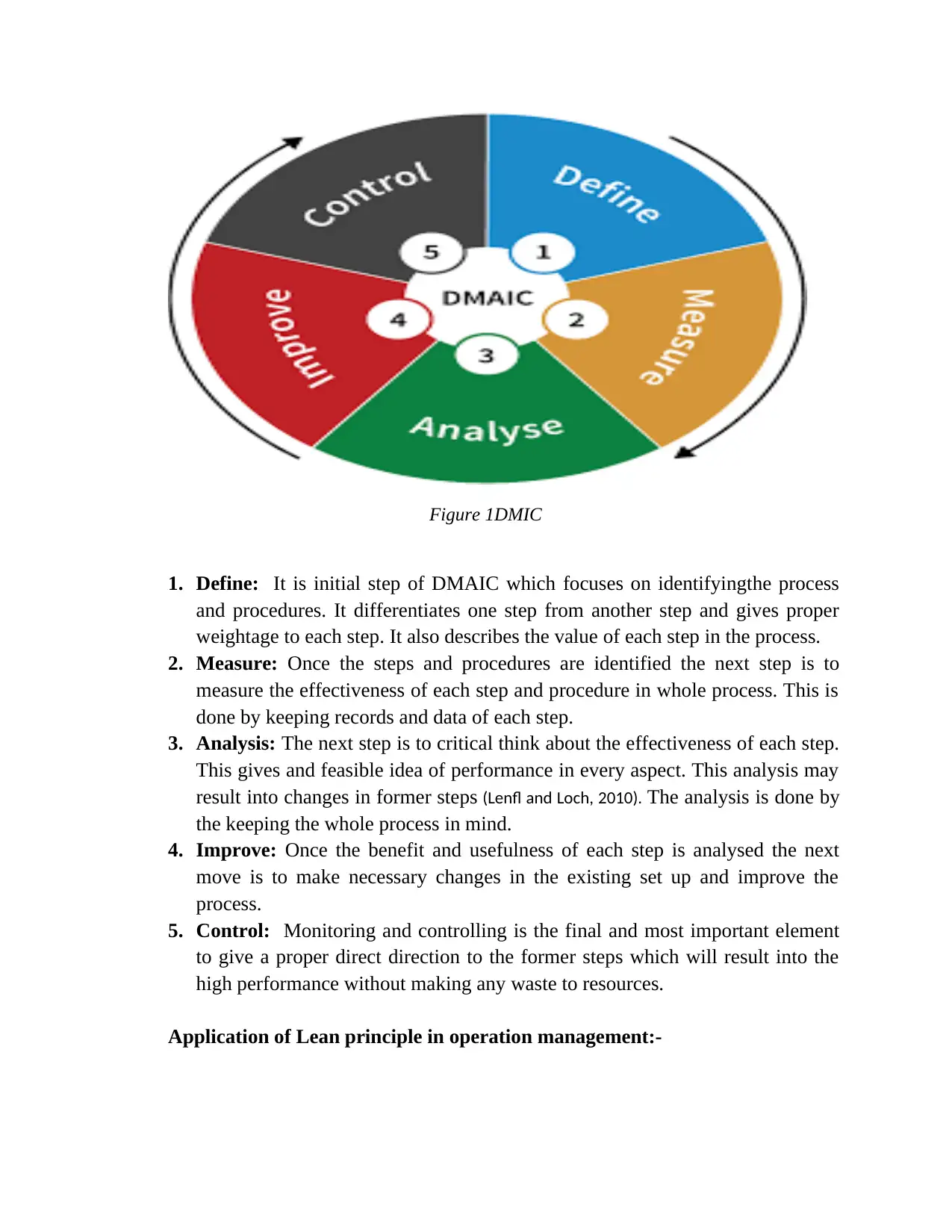
Figure 1DMIC
1. Define: It is initial step of DMAIC which focuses on identifyingthe process
and procedures. It differentiates one step from another step and gives proper
weightage to each step. It also describes the value of each step in the process.
2. Measure: Once the steps and procedures are identified the next step is to
measure the effectiveness of each step and procedure in whole process. This is
done by keeping records and data of each step.
3. Analysis: The next step is to critical think about the effectiveness of each step.
This gives and feasible idea of performance in every aspect. This analysis may
result into changes in former steps (Lenfl and Loch, 2010). The analysis is done by
the keeping the whole process in mind.
4. Improve: Once the benefit and usefulness of each step is analysed the next
move is to make necessary changes in the existing set up and improve the
process.
5. Control: Monitoring and controlling is the final and most important element
to give a proper direct direction to the former steps which will result into the
high performance without making any waste to resources.
Application of Lean principle in operation management:-
1. Define: It is initial step of DMAIC which focuses on identifyingthe process
and procedures. It differentiates one step from another step and gives proper
weightage to each step. It also describes the value of each step in the process.
2. Measure: Once the steps and procedures are identified the next step is to
measure the effectiveness of each step and procedure in whole process. This is
done by keeping records and data of each step.
3. Analysis: The next step is to critical think about the effectiveness of each step.
This gives and feasible idea of performance in every aspect. This analysis may
result into changes in former steps (Lenfl and Loch, 2010). The analysis is done by
the keeping the whole process in mind.
4. Improve: Once the benefit and usefulness of each step is analysed the next
move is to make necessary changes in the existing set up and improve the
process.
5. Control: Monitoring and controlling is the final and most important element
to give a proper direct direction to the former steps which will result into the
high performance without making any waste to resources.
Application of Lean principle in operation management:-
Paraphrase This Document
Need a fresh take? Get an instant paraphrase of this document with our AI Paraphraser
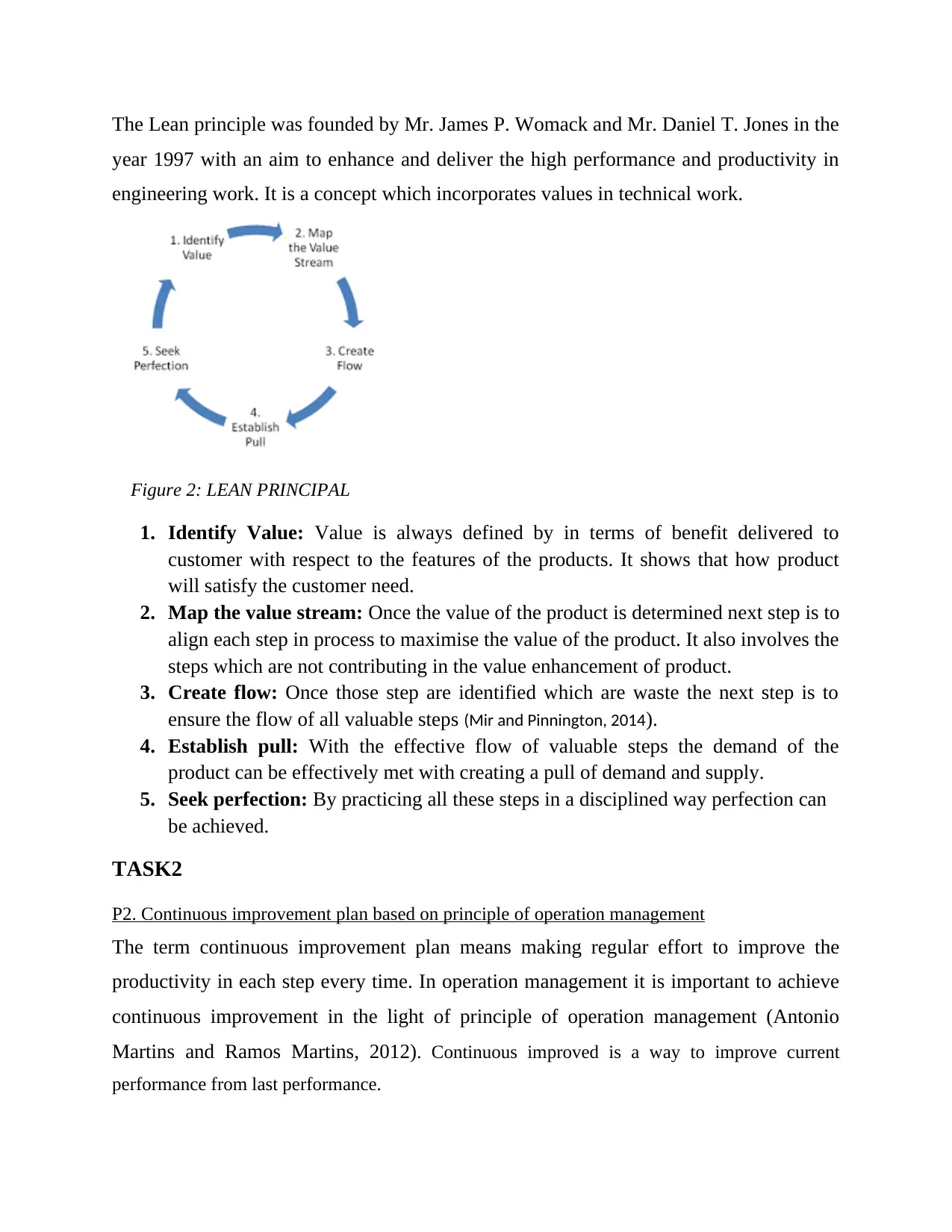
The Lean principle was founded by Mr. James P. Womack and Mr. Daniel T. Jones in the
year 1997 with an aim to enhance and deliver the high performance and productivity in
engineering work. It is a concept which incorporates values in technical work.
Figure 2: LEAN PRINCIPAL
1. Identify Value: Value is always defined by in terms of benefit delivered to
customer with respect to the features of the products. It shows that how product
will satisfy the customer need.
2. Map the value stream: Once the value of the product is determined next step is to
align each step in process to maximise the value of the product. It also involves the
steps which are not contributing in the value enhancement of product.
3. Create flow: Once those step are identified which are waste the next step is to
ensure the flow of all valuable steps (Mir and Pinnington, 2014).
4. Establish pull: With the effective flow of valuable steps the demand of the
product can be effectively met with creating a pull of demand and supply.
5. Seek perfection: By practicing all these steps in a disciplined way perfection can
be achieved.
TASK2
P2. Continuous improvement plan based on principle of operation management
The term continuous improvement plan means making regular effort to improve the
productivity in each step every time. In operation management it is important to achieve
continuous improvement in the light of principle of operation management (Antonio
Martins and Ramos Martins, 2012). Continuous improved is a way to improve current
performance from last performance.
year 1997 with an aim to enhance and deliver the high performance and productivity in
engineering work. It is a concept which incorporates values in technical work.
Figure 2: LEAN PRINCIPAL
1. Identify Value: Value is always defined by in terms of benefit delivered to
customer with respect to the features of the products. It shows that how product
will satisfy the customer need.
2. Map the value stream: Once the value of the product is determined next step is to
align each step in process to maximise the value of the product. It also involves the
steps which are not contributing in the value enhancement of product.
3. Create flow: Once those step are identified which are waste the next step is to
ensure the flow of all valuable steps (Mir and Pinnington, 2014).
4. Establish pull: With the effective flow of valuable steps the demand of the
product can be effectively met with creating a pull of demand and supply.
5. Seek perfection: By practicing all these steps in a disciplined way perfection can
be achieved.
TASK2
P2. Continuous improvement plan based on principle of operation management
The term continuous improvement plan means making regular effort to improve the
productivity in each step every time. In operation management it is important to achieve
continuous improvement in the light of principle of operation management (Antonio
Martins and Ramos Martins, 2012). Continuous improved is a way to improve current
performance from last performance.
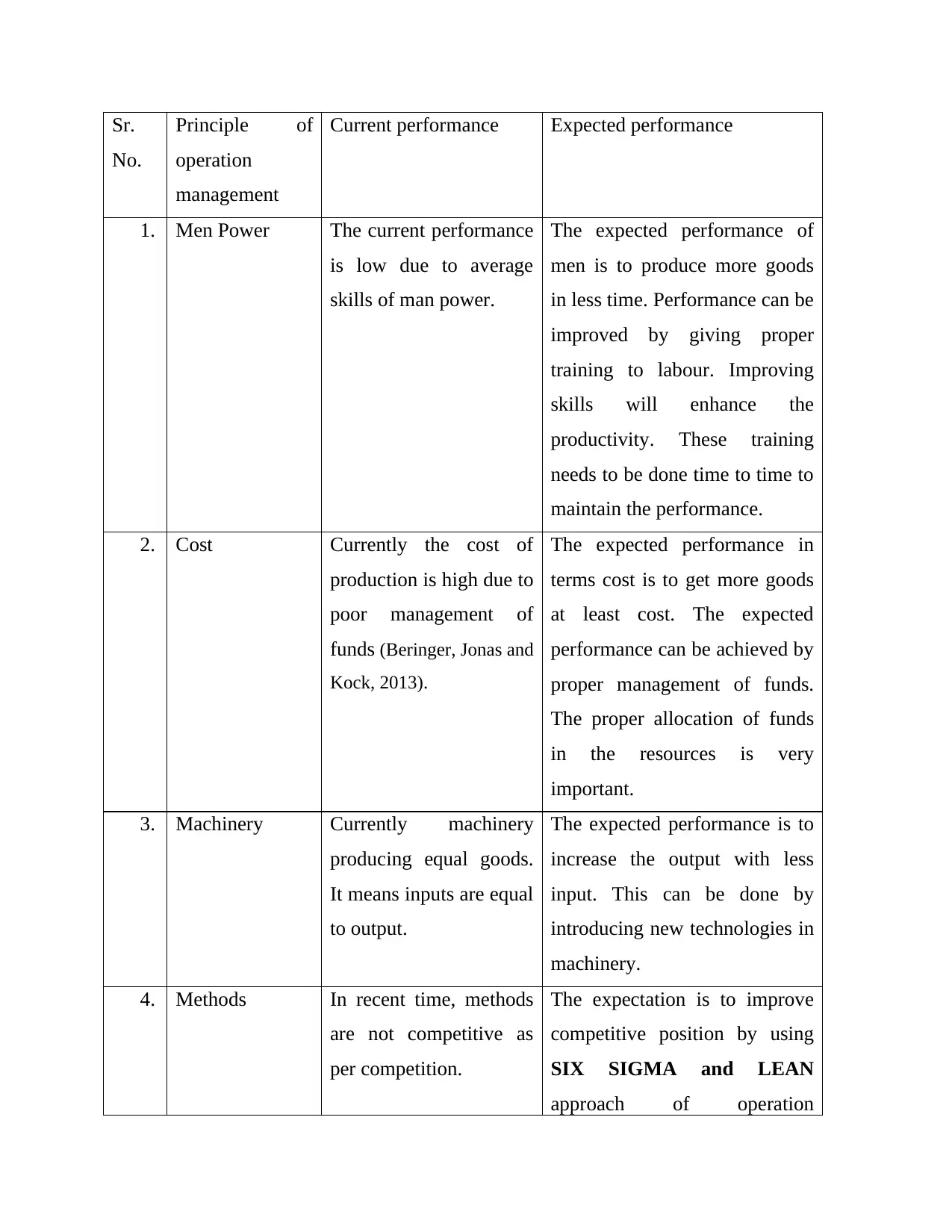
Sr.
No.
Principle of
operation
management
Current performance Expected performance
1. Men Power The current performance
is low due to average
skills of man power.
The expected performance of
men is to produce more goods
in less time. Performance can be
improved by giving proper
training to labour. Improving
skills will enhance the
productivity. These training
needs to be done time to time to
maintain the performance.
2. Cost Currently the cost of
production is high due to
poor management of
funds (Beringer, Jonas and
Kock, 2013).
The expected performance in
terms cost is to get more goods
at least cost. The expected
performance can be achieved by
proper management of funds.
The proper allocation of funds
in the resources is very
important.
3. Machinery Currently machinery
producing equal goods.
It means inputs are equal
to output.
The expected performance is to
increase the output with less
input. This can be done by
introducing new technologies in
machinery.
4. Methods In recent time, methods
are not competitive as
per competition.
The expectation is to improve
competitive position by using
SIX SIGMA and LEAN
approach of operation
No.
Principle of
operation
management
Current performance Expected performance
1. Men Power The current performance
is low due to average
skills of man power.
The expected performance of
men is to produce more goods
in less time. Performance can be
improved by giving proper
training to labour. Improving
skills will enhance the
productivity. These training
needs to be done time to time to
maintain the performance.
2. Cost Currently the cost of
production is high due to
poor management of
funds (Beringer, Jonas and
Kock, 2013).
The expected performance in
terms cost is to get more goods
at least cost. The expected
performance can be achieved by
proper management of funds.
The proper allocation of funds
in the resources is very
important.
3. Machinery Currently machinery
producing equal goods.
It means inputs are equal
to output.
The expected performance is to
increase the output with less
input. This can be done by
introducing new technologies in
machinery.
4. Methods In recent time, methods
are not competitive as
per competition.
The expectation is to improve
competitive position by using
SIX SIGMA and LEAN
approach of operation
⊘ This is a preview!⊘
Do you want full access?
Subscribe today to unlock all pages.

Trusted by 1+ million students worldwide
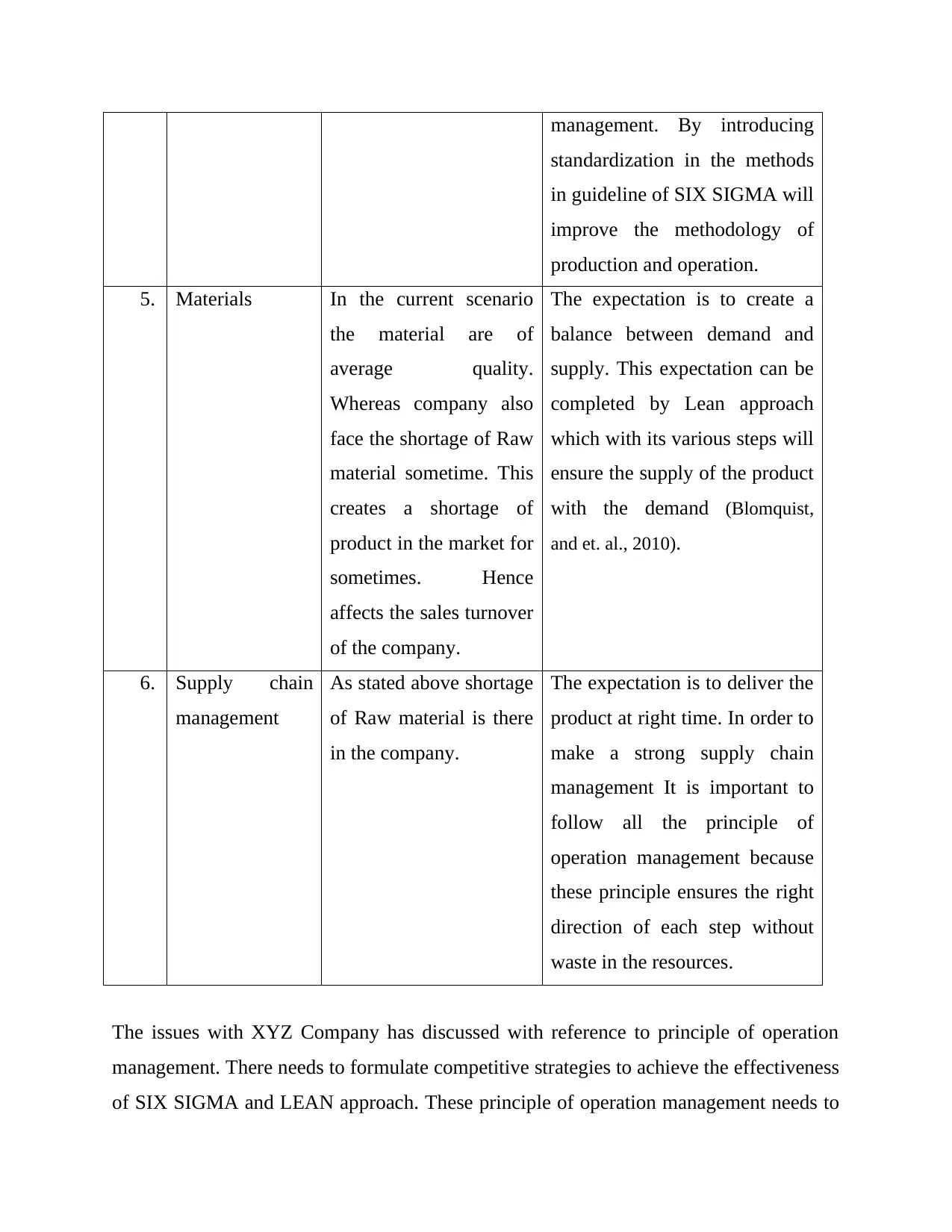
management. By introducing
standardization in the methods
in guideline of SIX SIGMA will
improve the methodology of
production and operation.
5. Materials In the current scenario
the material are of
average quality.
Whereas company also
face the shortage of Raw
material sometime. This
creates a shortage of
product in the market for
sometimes. Hence
affects the sales turnover
of the company.
The expectation is to create a
balance between demand and
supply. This expectation can be
completed by Lean approach
which with its various steps will
ensure the supply of the product
with the demand (Blomquist,
and et. al., 2010).
6. Supply chain
management
As stated above shortage
of Raw material is there
in the company.
The expectation is to deliver the
product at right time. In order to
make a strong supply chain
management It is important to
follow all the principle of
operation management because
these principle ensures the right
direction of each step without
waste in the resources.
The issues with XYZ Company has discussed with reference to principle of operation
management. There needs to formulate competitive strategies to achieve the effectiveness
of SIX SIGMA and LEAN approach. These principle of operation management needs to
standardization in the methods
in guideline of SIX SIGMA will
improve the methodology of
production and operation.
5. Materials In the current scenario
the material are of
average quality.
Whereas company also
face the shortage of Raw
material sometime. This
creates a shortage of
product in the market for
sometimes. Hence
affects the sales turnover
of the company.
The expectation is to create a
balance between demand and
supply. This expectation can be
completed by Lean approach
which with its various steps will
ensure the supply of the product
with the demand (Blomquist,
and et. al., 2010).
6. Supply chain
management
As stated above shortage
of Raw material is there
in the company.
The expectation is to deliver the
product at right time. In order to
make a strong supply chain
management It is important to
follow all the principle of
operation management because
these principle ensures the right
direction of each step without
waste in the resources.
The issues with XYZ Company has discussed with reference to principle of operation
management. There needs to formulate competitive strategies to achieve the effectiveness
of SIX SIGMA and LEAN approach. These principle of operation management needs to
Paraphrase This Document
Need a fresh take? Get an instant paraphrase of this document with our AI Paraphraser
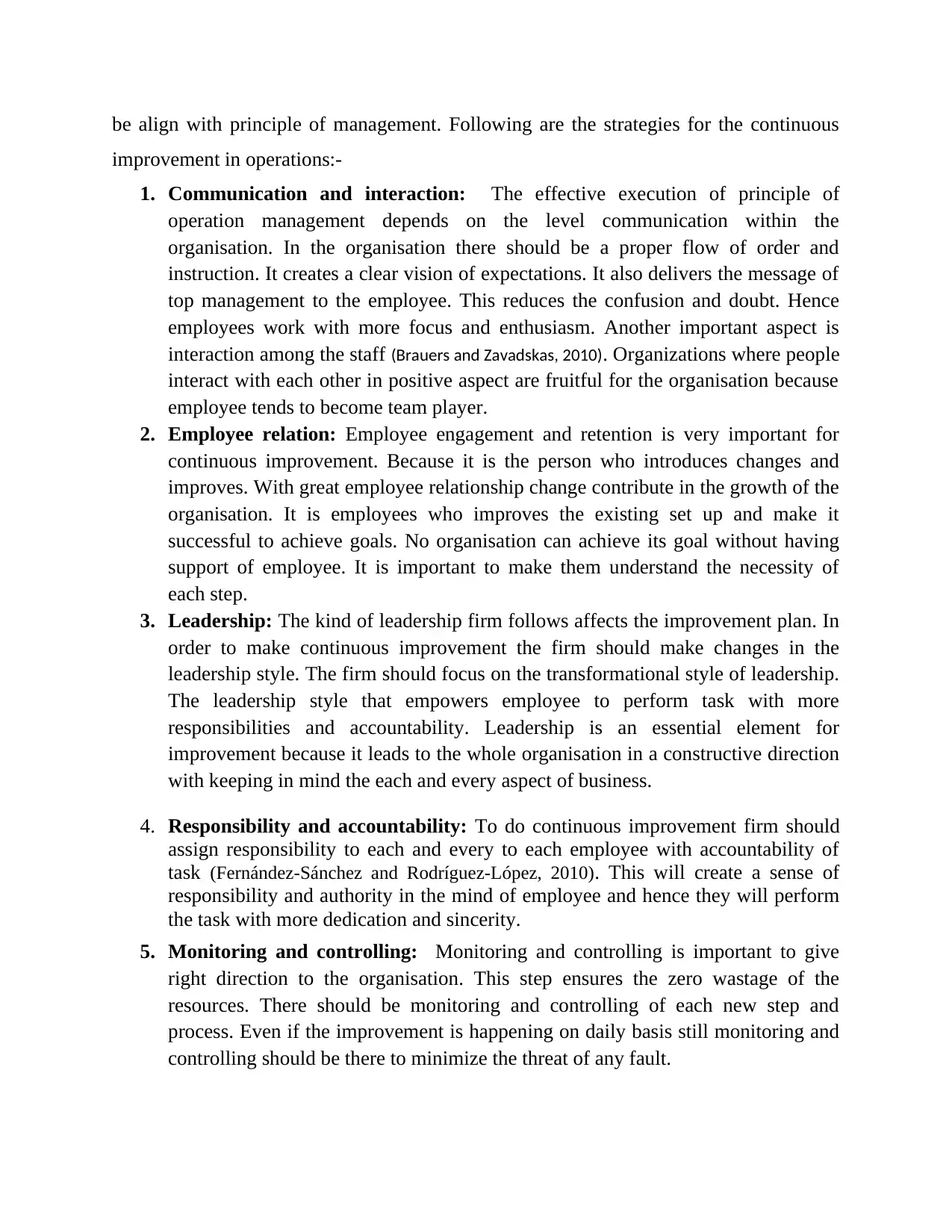
be align with principle of management. Following are the strategies for the continuous
improvement in operations:-
1. Communication and interaction: The effective execution of principle of
operation management depends on the level communication within the
organisation. In the organisation there should be a proper flow of order and
instruction. It creates a clear vision of expectations. It also delivers the message of
top management to the employee. This reduces the confusion and doubt. Hence
employees work with more focus and enthusiasm. Another important aspect is
interaction among the staff (Brauers and Zavadskas, 2010). Organizations where people
interact with each other in positive aspect are fruitful for the organisation because
employee tends to become team player.
2. Employee relation: Employee engagement and retention is very important for
continuous improvement. Because it is the person who introduces changes and
improves. With great employee relationship change contribute in the growth of the
organisation. It is employees who improves the existing set up and make it
successful to achieve goals. No organisation can achieve its goal without having
support of employee. It is important to make them understand the necessity of
each step.
3. Leadership: The kind of leadership firm follows affects the improvement plan. In
order to make continuous improvement the firm should make changes in the
leadership style. The firm should focus on the transformational style of leadership.
The leadership style that empowers employee to perform task with more
responsibilities and accountability. Leadership is an essential element for
improvement because it leads to the whole organisation in a constructive direction
with keeping in mind the each and every aspect of business.
4. Responsibility and accountability: To do continuous improvement firm should
assign responsibility to each and every to each employee with accountability of
task (Fernández-Sánchez and Rodríguez-López, 2010). This will create a sense of
responsibility and authority in the mind of employee and hence they will perform
the task with more dedication and sincerity.
5. Monitoring and controlling: Monitoring and controlling is important to give
right direction to the organisation. This step ensures the zero wastage of the
resources. There should be monitoring and controlling of each new step and
process. Even if the improvement is happening on daily basis still monitoring and
controlling should be there to minimize the threat of any fault.
improvement in operations:-
1. Communication and interaction: The effective execution of principle of
operation management depends on the level communication within the
organisation. In the organisation there should be a proper flow of order and
instruction. It creates a clear vision of expectations. It also delivers the message of
top management to the employee. This reduces the confusion and doubt. Hence
employees work with more focus and enthusiasm. Another important aspect is
interaction among the staff (Brauers and Zavadskas, 2010). Organizations where people
interact with each other in positive aspect are fruitful for the organisation because
employee tends to become team player.
2. Employee relation: Employee engagement and retention is very important for
continuous improvement. Because it is the person who introduces changes and
improves. With great employee relationship change contribute in the growth of the
organisation. It is employees who improves the existing set up and make it
successful to achieve goals. No organisation can achieve its goal without having
support of employee. It is important to make them understand the necessity of
each step.
3. Leadership: The kind of leadership firm follows affects the improvement plan. In
order to make continuous improvement the firm should make changes in the
leadership style. The firm should focus on the transformational style of leadership.
The leadership style that empowers employee to perform task with more
responsibilities and accountability. Leadership is an essential element for
improvement because it leads to the whole organisation in a constructive direction
with keeping in mind the each and every aspect of business.
4. Responsibility and accountability: To do continuous improvement firm should
assign responsibility to each and every to each employee with accountability of
task (Fernández-Sánchez and Rodríguez-López, 2010). This will create a sense of
responsibility and authority in the mind of employee and hence they will perform
the task with more dedication and sincerity.
5. Monitoring and controlling: Monitoring and controlling is important to give
right direction to the organisation. This step ensures the zero wastage of the
resources. There should be monitoring and controlling of each new step and
process. Even if the improvement is happening on daily basis still monitoring and
controlling should be there to minimize the threat of any fault.
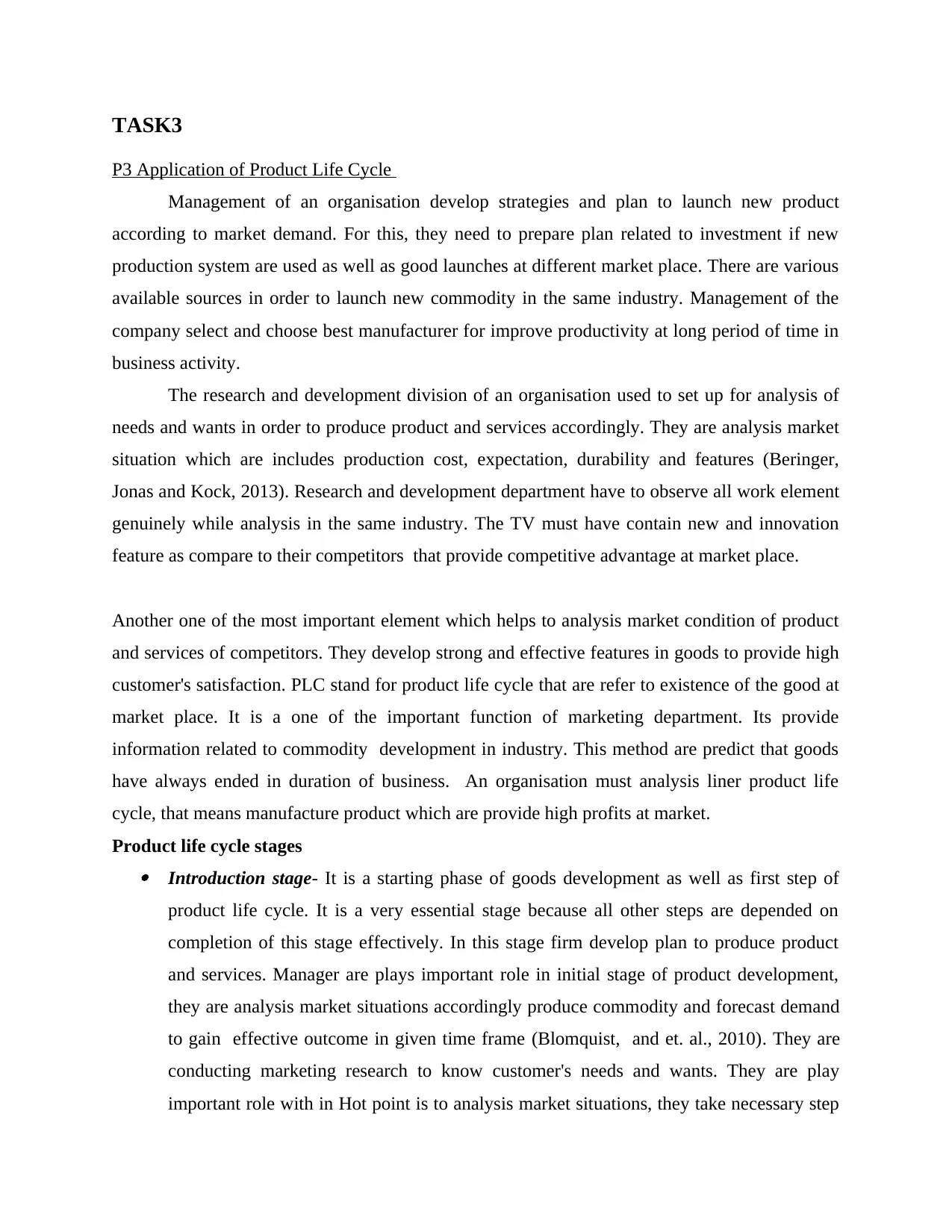
TASK3
P3 Application of Product Life Cycle
Management of an organisation develop strategies and plan to launch new product
according to market demand. For this, they need to prepare plan related to investment if new
production system are used as well as good launches at different market place. There are various
available sources in order to launch new commodity in the same industry. Management of the
company select and choose best manufacturer for improve productivity at long period of time in
business activity.
The research and development division of an organisation used to set up for analysis of
needs and wants in order to produce product and services accordingly. They are analysis market
situation which are includes production cost, expectation, durability and features (Beringer,
Jonas and Kock, 2013). Research and development department have to observe all work element
genuinely while analysis in the same industry. The TV must have contain new and innovation
feature as compare to their competitors that provide competitive advantage at market place.
Another one of the most important element which helps to analysis market condition of product
and services of competitors. They develop strong and effective features in goods to provide high
customer's satisfaction. PLC stand for product life cycle that are refer to existence of the good at
market place. It is a one of the important function of marketing department. Its provide
information related to commodity development in industry. This method are predict that goods
have always ended in duration of business. An organisation must analysis liner product life
cycle, that means manufacture product which are provide high profits at market.
Product life cycle stages Introduction stage- It is a starting phase of goods development as well as first step of
product life cycle. It is a very essential stage because all other steps are depended on
completion of this stage effectively. In this stage firm develop plan to produce product
and services. Manager are plays important role in initial stage of product development,
they are analysis market situations accordingly produce commodity and forecast demand
to gain effective outcome in given time frame (Blomquist, and et. al., 2010). They are
conducting marketing research to know customer's needs and wants. They are play
important role with in Hot point is to analysis market situations, they take necessary step
P3 Application of Product Life Cycle
Management of an organisation develop strategies and plan to launch new product
according to market demand. For this, they need to prepare plan related to investment if new
production system are used as well as good launches at different market place. There are various
available sources in order to launch new commodity in the same industry. Management of the
company select and choose best manufacturer for improve productivity at long period of time in
business activity.
The research and development division of an organisation used to set up for analysis of
needs and wants in order to produce product and services accordingly. They are analysis market
situation which are includes production cost, expectation, durability and features (Beringer,
Jonas and Kock, 2013). Research and development department have to observe all work element
genuinely while analysis in the same industry. The TV must have contain new and innovation
feature as compare to their competitors that provide competitive advantage at market place.
Another one of the most important element which helps to analysis market condition of product
and services of competitors. They develop strong and effective features in goods to provide high
customer's satisfaction. PLC stand for product life cycle that are refer to existence of the good at
market place. It is a one of the important function of marketing department. Its provide
information related to commodity development in industry. This method are predict that goods
have always ended in duration of business. An organisation must analysis liner product life
cycle, that means manufacture product which are provide high profits at market.
Product life cycle stages Introduction stage- It is a starting phase of goods development as well as first step of
product life cycle. It is a very essential stage because all other steps are depended on
completion of this stage effectively. In this stage firm develop plan to produce product
and services. Manager are plays important role in initial stage of product development,
they are analysis market situations accordingly produce commodity and forecast demand
to gain effective outcome in given time frame (Blomquist, and et. al., 2010). They are
conducting marketing research to know customer's needs and wants. They are play
important role with in Hot point is to analysis market situations, they take necessary step
⊘ This is a preview!⊘
Do you want full access?
Subscribe today to unlock all pages.

Trusted by 1+ million students worldwide
1 out of 18
Related Documents
Your All-in-One AI-Powered Toolkit for Academic Success.
+13062052269
info@desklib.com
Available 24*7 on WhatsApp / Email
![[object Object]](/_next/static/media/star-bottom.7253800d.svg)
Unlock your academic potential
Copyright © 2020–2025 A2Z Services. All Rights Reserved. Developed and managed by ZUCOL.





